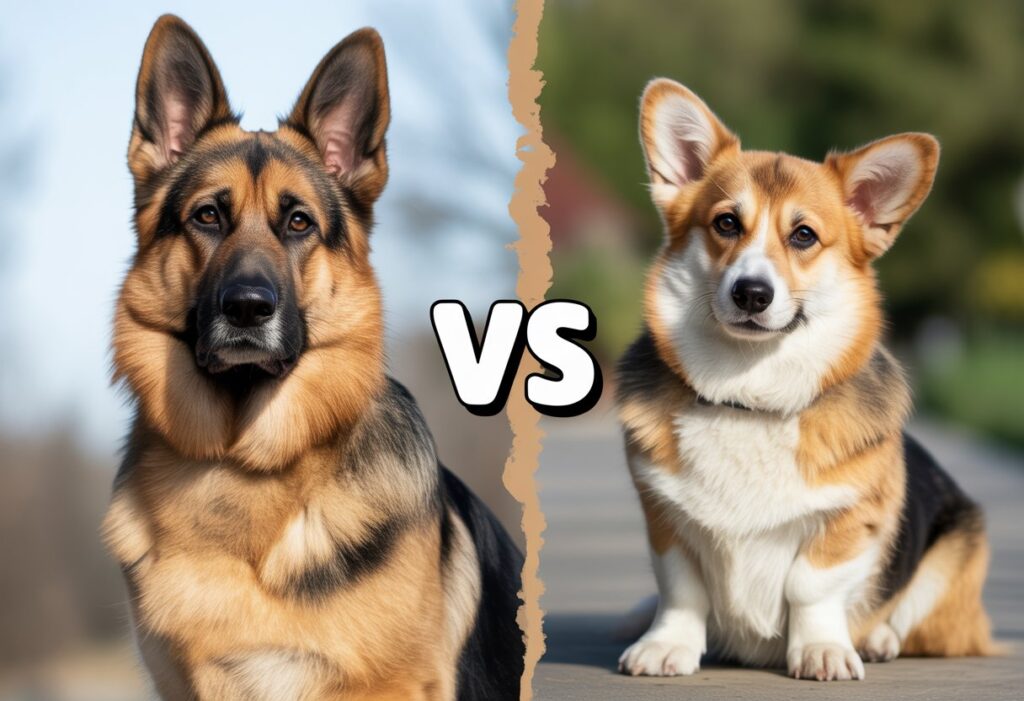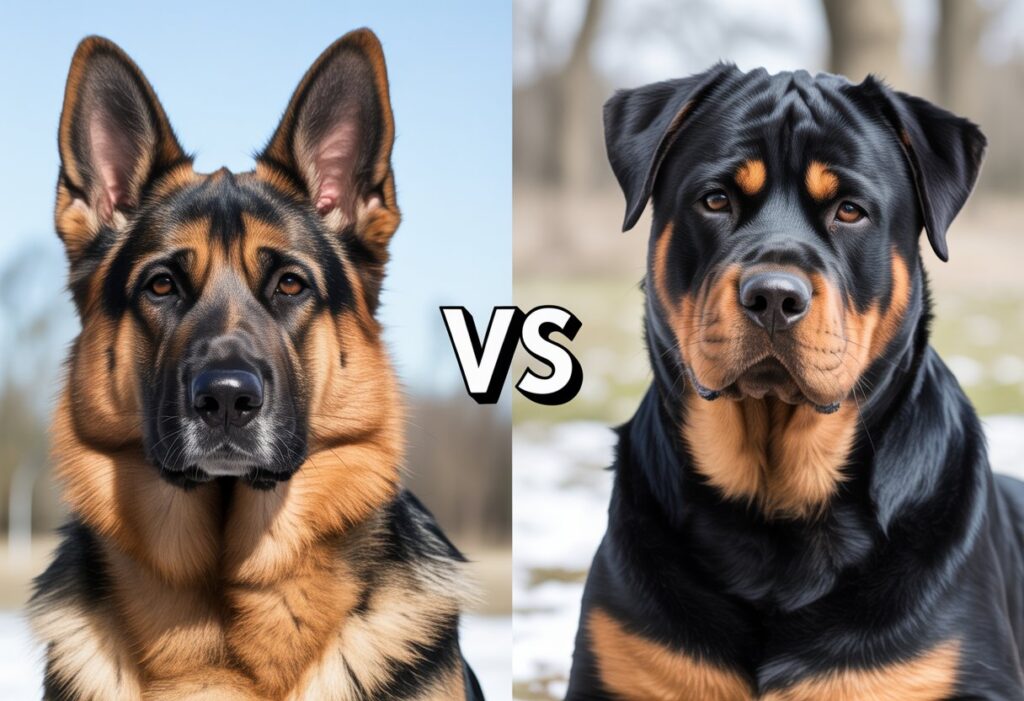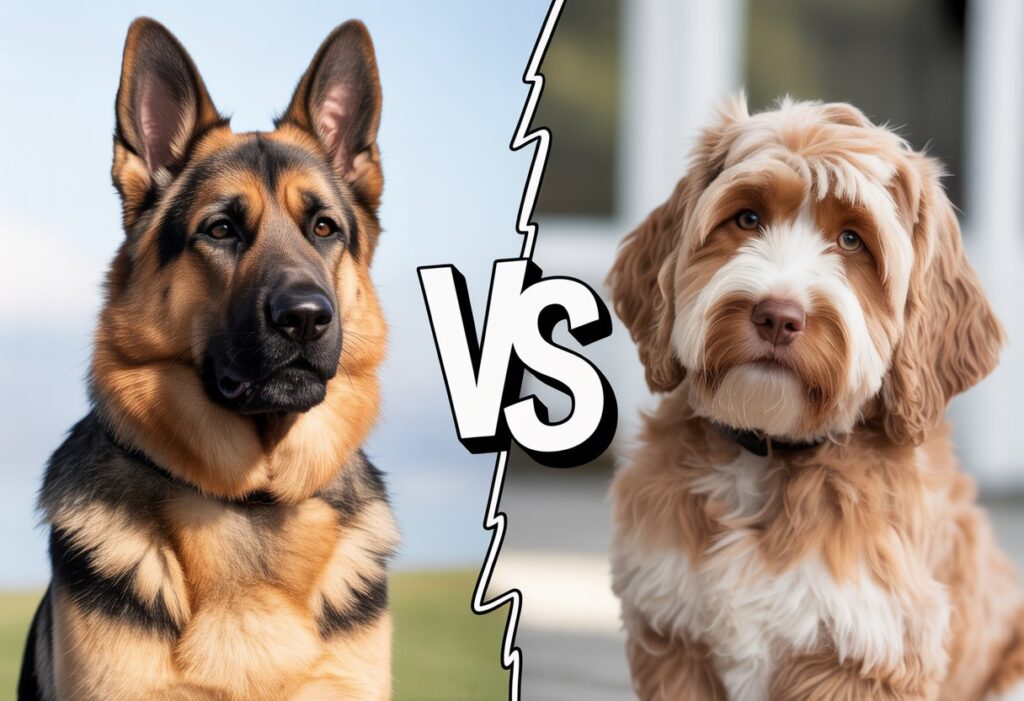Choosing between a German Shepherd and a Pembroke Welsh Corgi is a big decision if you want the right dog for your home. German Shepherds are large, loyal working dogs, while Pembroke Welsh Corgis are small, energetic, and friendly.
By understanding their differences in size, personality, and care needs, you can figure out which breed fits best with your lifestyle.
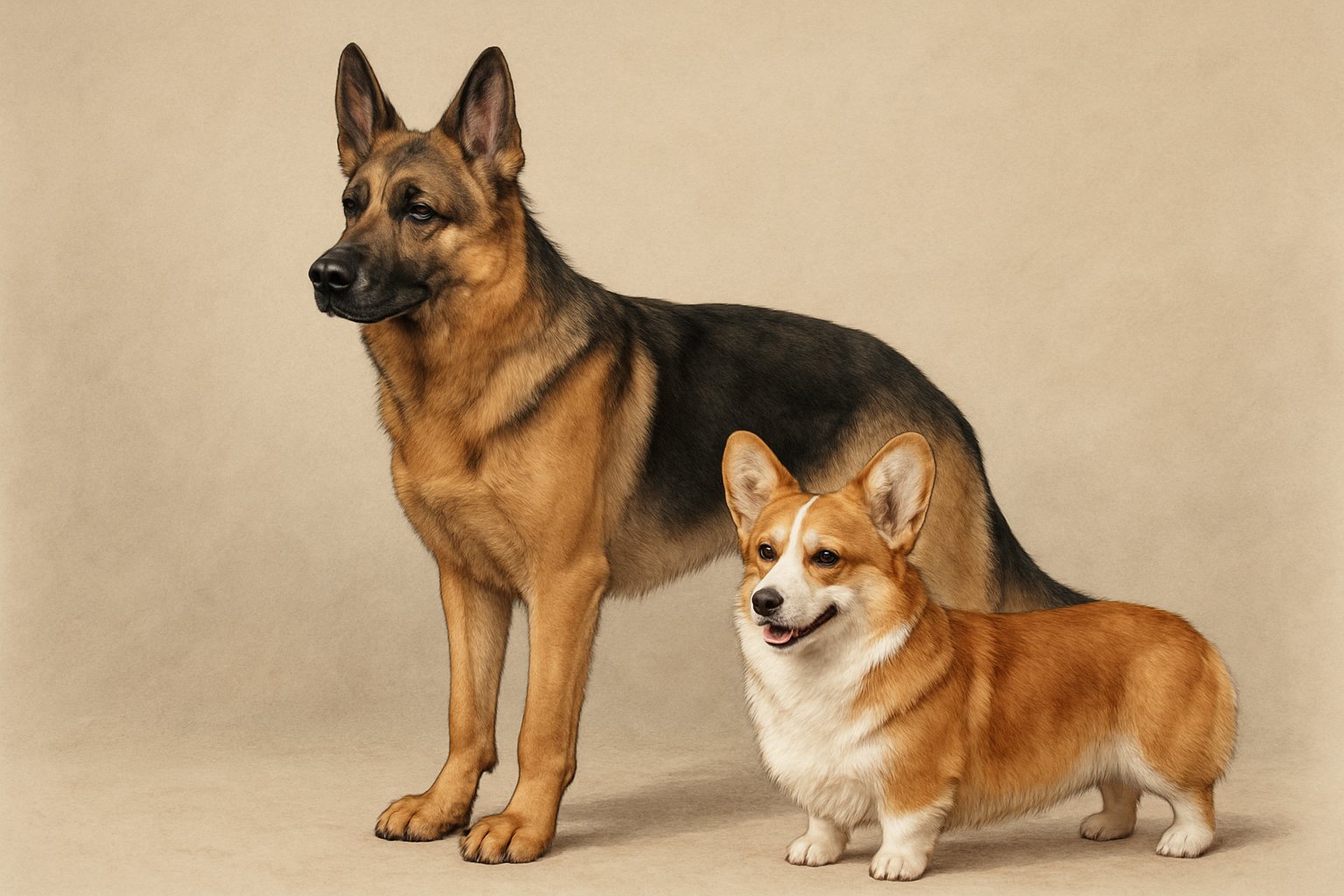
These two breeds have very different histories and looks. Still, both can make great pets in the right environment.
Knowing what to expect from each dog helps you decide whether you want a family companion, a working partner, or just a playful friend for your kids.
Key Takeaways
- German Shepherds and Corgis have different sizes and purposes.
- Each breed has a unique personality and training style.
- Health, care, and popularity vary between the two.
Breed Origins and History
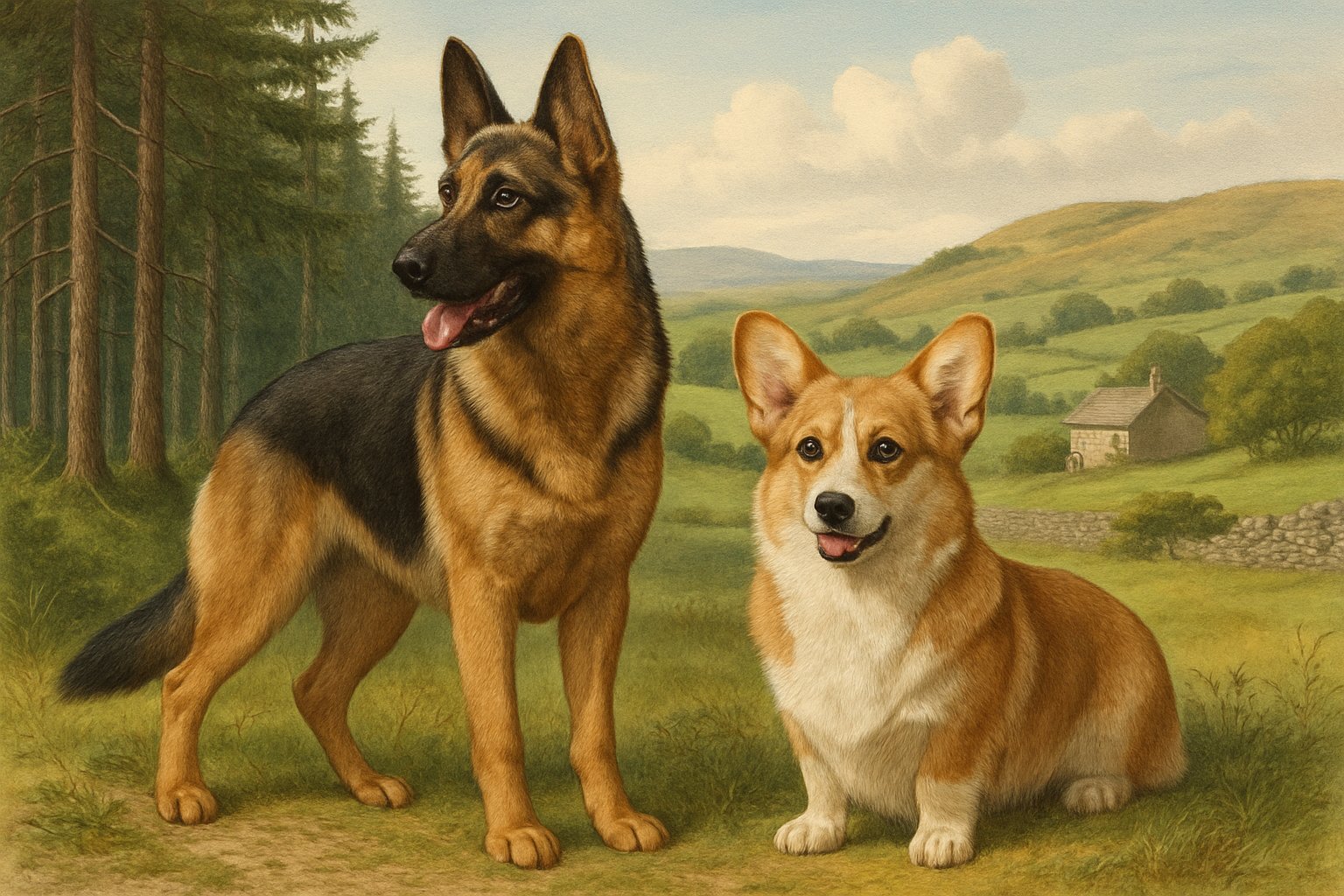
Both the German Shepherd and the Pembroke Welsh Corgi started as herding dogs, but their backgrounds are pretty different. Each breed’s story shapes its personality and work style.
German Shepherd Background
The German Shepherd came from Germany in the late 1800s. Captain Max von Stephanitz wanted a smart, strong herding dog, so he started with local sheepdogs and refined the breed for work and obedience.
German Shepherds quickly caught the attention of police and military forces. Their intelligence, loyalty, and trainability made them favorites for jobs outside herding.
Today, you’ll see them as service dogs, search and rescue dogs, and in all kinds of working settings. In Germany, their formal name is Deutscher Schäferhund.
Shepherds have a reputation for being protective and focused. They’re eager to learn and often remind people of other German breeds like the Rottweiler and Boxer.
Pembroke Welsh Corgi Background
The Pembroke Welsh Corgi is one of two Corgi breeds from Wales. The other is the Cardigan Welsh Corgi.
Pembrokes were bred for herding cattle in Pembrokeshire, Wales, as early as the 10th century. They’re much smaller than German Shepherds, with short legs and long bodies.
Their build helped them nip at the heels of cattle and dodge kicks. Some old legends even claim fairies rode them, but farmers really valued their hard work and alertness.
Pembrokes are outgoing, smart, and energetic. Their popularity soared in the 20th century, especially after Queen Elizabeth II started keeping several as pets.
Pembrokes stand out from Cardigans thanks to their docked or naturally short tail and slightly different ears.
Comparison with Other Herding Dogs
German Shepherds and Pembroke Welsh Corgis both began as herding breeds. But their size and herding style are pretty different.
Shepherds are large and powerful, used for guarding as well as herding. Corgis, on the other hand, use their low height and quick moves to control livestock.
Compared to other herding breeds like the Collie or Border Collie, Shepherds tend to be more protective. Collies shine at speed and agility.
Corgis are closest to Cardigan Welsh Corgis, but Cardigans are a bit bigger and have a bushy tail.
Labrador Retrievers, Golden Retrievers, Mastiffs, and Boxers also come from working or herding backgrounds. They’re usually larger or have different work styles.
Each breed’s origin shapes its skills and trainability.
Physical Characteristics and Appearance
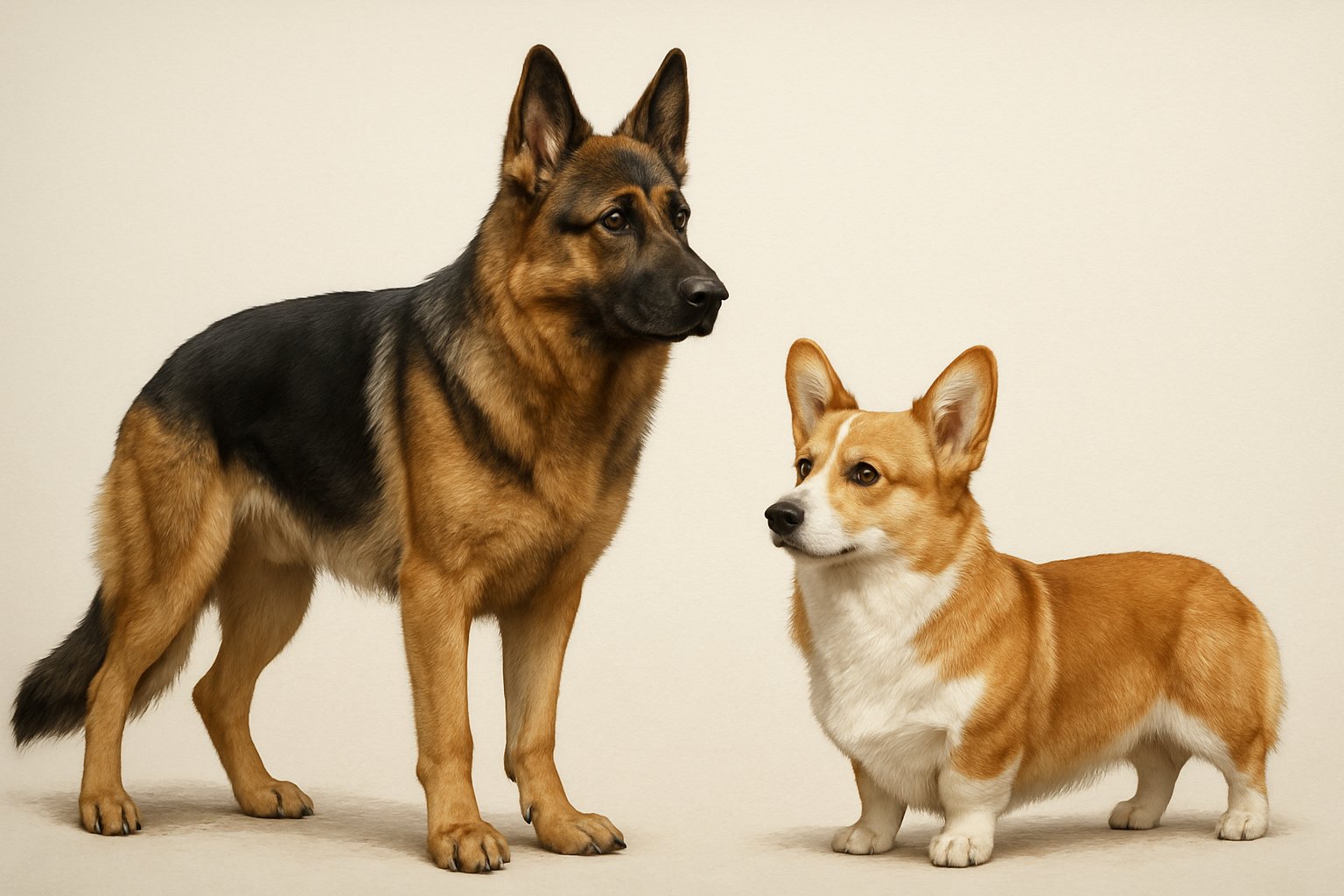
German Shepherds and Pembroke Welsh Corgis look nothing alike in size, shape, or body features. Their coats, tails, and even genetic quirks set them apart.
Size and Build
German Shepherds are large, powerful dogs. Males typically stand 24 to 26 inches tall at the shoulder, while females are around 22 to 24 inches.
They usually weigh between 50 and 90 pounds. Their bodies look strong, with a straight back and a deep chest.
Pembroke Welsh Corgis are much smaller. They measure about 10 to 12 inches high at the shoulder and usually weigh 25 to 30 pounds.
Corgis have long bodies and short legs. People often describe their build as low-set and sturdy.
German Shepherds have longer legs and an athletic shape. Corgis’ short legs come from a gene that causes dwarfism, giving them their unique look.
Coat Type and Color
German Shepherds have a double coat. The undercoat is dense and soft, while the outer coat is straight and rough.
Their coat length can be medium or long. Common colors include black and tan, sable, black, and sometimes gray or white.
Pembroke Welsh Corgis also have a double coat. Their fur is medium in length and often thicker, sometimes softer than a Shepherd’s.
Corgis come in colors like red, sable, fawn, black and tan, often with white markings on the face, neck, chest, legs, and tail area.
Both breeds shed a lot. Corgis might seem fluffier because of their build and coat volume.
Regular grooming is a must for both if you want to control shedding and keep their fur healthy.
Tail Docking and Tail Length
German Shepherds are born with long, bushy tails that hang down naturally. Their tails aren’t docked—ever.
Pembroke Welsh Corgis are known for their short tails. In some countries, breeders dock the tail a few days after birth to meet breed standards.
In other places, where docking is banned, some Pembrokes keep their full natural tails. Natural tails in Pembrokes are medium in length and set low.
The Cardigan Welsh Corgi always has a long tail. If you see a Corgi with a long tail, it might be a Cardigan, not a Pembroke.
Chondrodysplasia in Corgis
Chondrodysplasia is a genetic condition you’ll spot in Pembroke Welsh Corgis. It’s a type of dwarfism caused by a gene mutation.
This leads to their short legs and long body. Because of chondrodysplasia, Corgis are at higher risk for joint and back issues, including intervertebral disc disease.
Their unique shape means you should be careful with activities that involve jumping, stairs, or rough play.
German Shepherds don’t have chondrodysplasia, so their legs and body are more balanced. They can run, jump, and work in ways that Corgis just can’t.
Temperament and Personality
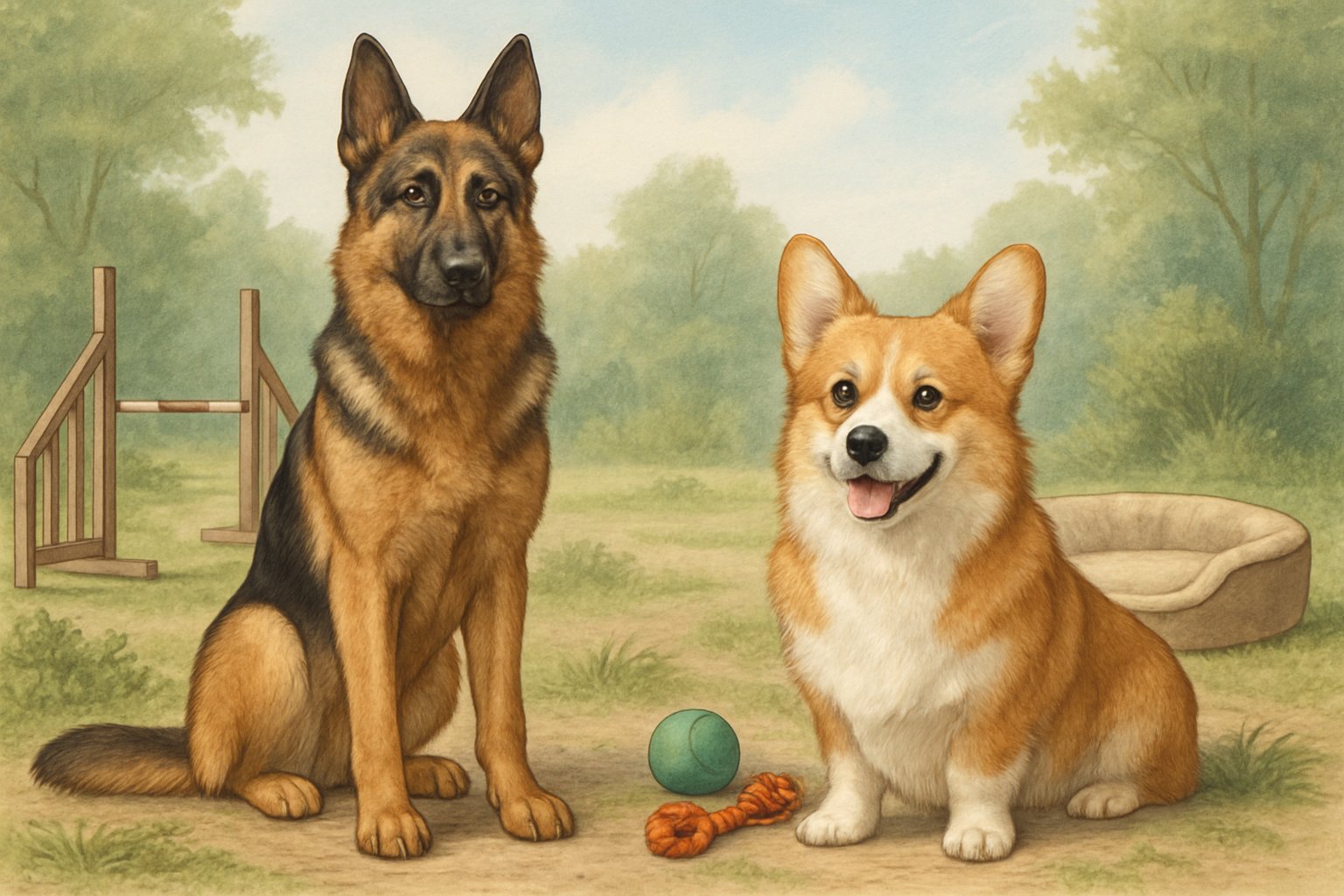
German Shepherds are known for their loyalty, protectiveness, and intelligence. Pembroke Welsh Corgis are famous for being friendly, alert, and playful.
Both breeds stand out as family pets, but their day-to-day behaviors can be very different.
Behavior with Family and Children
German Shepherds build strong bonds with their families. They’re watchful and caring, making them excellent protectors.
Many families trust them around children because of their patient nature. They want to keep loved ones safe.
Pembroke Welsh Corgis bring energy and fun into the home. They love being part of family routines and are usually gentle with kids.
Corgis can be a little bossy at times, but they use playfulness instead of roughness. You should always watch any dog around young children, including Corgis, Shepherds, Poodles, Bulldogs, or French Bulldogs.
Early socialization and teaching kids how to respect pets help everyone get along.
Interaction with Other Pets
German Shepherds are often polite with other household pets if they grow up together. Their herding and guarding instincts can show up around new animals.
Early training helps them relax and get along, especially if you already have another family pet like a Poodle or French Bulldog.
Corgis were bred for herding too, so they might try to “herd” other pets—even cats. Most Corgis get along with other dogs, especially if they meet them as puppies.
Their bold attitude can sometimes annoy bigger, calmer animals like a Bulldog. Introducing pets slowly and under control works best.
Give each animal personal space and attention. Never force them together.
Energy Levels
German Shepherds are highly active and need a job to do. They do best with two walks a day and plenty of playtime.
Without enough exercise, Shepherds can get restless or even destructive. Pembroke Welsh Corgis have a lot of energy packed into a smaller body.
They love games, outdoor walks, and chasing balls. Regular play keeps them happy and stops them from picking up bad habits.
Both breeds need daily activity, but Shepherds need more intense workouts. Corgis enjoy short bursts of play.
Keeping their minds busy matters as much as physical exercise for both breeds.
Training and Intelligence
German Shepherds and Pembroke Welsh Corgis are both highly intelligent, but their strengths in training can differ. Both breeds respond best to consistent, positive methods and early guidance.
Obedience and Trainability
German Shepherds are quick learners and eager to please. They’re often chosen for police and service work because they follow commands well.
You can usually teach a German Shepherd both basic and advanced skills with little fuss. Pembroke Welsh Corgis learn quickly too, but they can be a bit stubborn.
They respond best to short, fun learning sessions. Treats or a favorite toy help keep their attention and make them more likely to listen.
Here’s a quick comparison:
| Trait | German Shepherd | Pembroke Welsh Corgi |
|---|---|---|
| Follows Commands | Very Well | Well |
| Learns New Tricks | Very Quickly | Quickly |
| Attention Span | High | Moderate |
| Repetition Needed | Low | Moderate |
Both breeds need patience and regular lessons. Your training plan should match each dog’s learning style.
Socialization Needs
German Shepherds can act wary around strangers without proper socialization. Exposing your dog to new people and places as a puppy helps prevent fear and builds confidence.
Group classes and visits to busy parks help your German Shepherd adjust to all kinds of experiences. Pembroke Welsh Corgis are usually more outgoing but can be shy.
They need to meet other dogs and people early so they don’t develop bad habits like barking or herding children. Fun games, new toys, and friendly visitors make socializing easier for Corgis.
Both breeds benefit from early socialization. Consistency and gradual exposure matter.
Keeping social experiences positive helps your dog learn to react calmly in different situations.
Health and Care Considerations
German Shepherds and Pembroke Welsh Corgis need different types of care and daily routines. Focus on their main health problems, exercise needs, and how often you should groom them.
Common Health Problems
Both breeds face some unique health risks. German Shepherds often deal with hip dysplasia, elbow dysplasia, and degenerative myelopathy.
These issues can mess with their movement and overall quality of life. It’s smart to get early screening and keep up with regular checkups.
Pembroke Welsh Corgis have a higher risk for intervertebral disc disease (IVDD) because of their long backs and short legs. This can lead to back pain and mobility problems.
Corgis might also get hip dysplasia and degenerative myelopathy. Keeping their weight in check really helps protect their joints and back.
Exercise Requirements
Both breeds need daily exercise, but they’re not the same. German Shepherds are super active and need about 1–2 hours of exercise—think walking, running, or playing fetch.
They love activities that challenge their brains, thanks to their working-dog instincts. Pembroke Welsh Corgis need regular walks and playtime too, but 30–60 minutes a day usually does the trick.
Corgis have bursts of energy but wear out faster than German Shepherds. Try to avoid long jumps or rough play, since their backs are a bit fragile.
Grooming Needs
Both breeds shed, but the grooming routine isn’t identical. German Shepherds have a thick double coat that sheds a lot all year, especially in spring and fall.
Brushing them several times a week—or even daily during heavy shedding—helps control loose fur and keeps their coat in decent shape. Pembroke Welsh Corgis shed plenty too, though their fur is shorter.
Weekly brushing does the job for most Corgis, keeping dead hair off your floors. You’ll also want to check their ears, trim their nails, and brush their teeth regularly.
That way, you’re not just keeping them clean—you’re also spotting early signs of skin or health issues.
Corgi Puppies and Notable Owners
Corgi puppies are a hit for their playful spirit and quirky looks. Queen Elizabeth II famously owned Pembroke Welsh Corgis, which definitely helped put the breed on the map.
Choosing a Corgi Puppy
If you’re picking out a Pembroke Welsh Corgi puppy, keep health and temperament in mind. Look for alert, curious, and friendly pups.
Good breeders share health records and usually let you meet the puppy’s parents. Since Corgis can have back problems, it’s best to pick a puppy from a breeder who does genetic screenings.
Ask what kind of socialization the puppies have had. Early socialization makes a big difference for a well-adjusted adult dog.
Make sure your home and yard are ready for a smart, energetic puppy. You’ll want to keep things safe and puppy-proofed.
Checklist for Choosing a Corgi Puppy:
- Health records and vaccination history
- Socialization with people and pets
- Parents have calm, friendly temperaments
- Clear information on genetic testing
Queen Elizabeth II and Corgis
Queen Elizabeth II has always been linked with Pembroke Welsh Corgis. She got her first Corgi, Dookie, as a child back in the 1930s.
Over the years, she owned more than 30 Corgis. They showed up in official photos and celebrations all the time.
The Queen’s love for these dogs helped make Corgis famous well beyond the UK. Her Corgis became a big part of her public image, popping up at royal events, parades, and even on TV.
She bred several generations of Corgis at Windsor Castle. After seeing them with the Queen, a lot of people started to appreciate the breed’s loyalty and cheerful personality.

